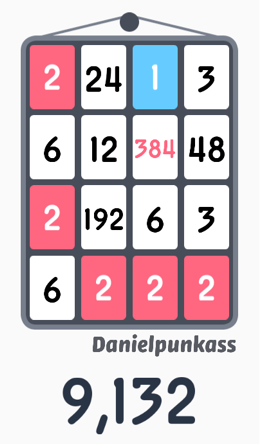I mentioned in my previous post about Threes that the game is seductive because it’s easy to do well as a beginner, but much harder to do “really well”. I also pointed out that looking at the Game Center leaderboard might give you an idea of how well you’re actually doing.
As much as I enjoy the game, there is a weakness in the way they neglect to connect you with your score as you play. I have found that after playing a relatively long game, I am very unlikely to have a good sense of how well I’m doing. You never learn you score until after you’ve lost and the final tally is made.
I was chatting with Manton Reece about the game and realized I didn’t even understand precisely how it was scored. I knew that the longer you played, and thus the more tiles you combine, the higher the score. And I knew that the scores seemed to get exponentially higher the longer you play. That is to say, if you combine 20 tiles you will have far more than twice the points you would have gotten by combining 10 tiles.
In short: the score goes through the roof quickly, and somebody on the Game Center leaderboard with a much higher score than you may not have survived all that much longer than you did.
Here’s my highest scoring game to date:

So how is it scored? The 2s and 1s are worthless, and the rest of the tiles are each valued based on the number of times it has combined with a pair. Specifically, the score is 3^N where N is the number of times it doubled since it was 3. For any face value “x”, the score is 3^(log₂(x/3)+1). So “3” is worth 3 points, “6” is worth 9, “384” is worth 6,561, and if you’re so lucky as to combine a given tile 11 times, the “6144” face value will earn you a whopping 531,441 points.
Here’s a handy chart, based on a WolframAlpha equation I hacked together:
| Face Value: | 3 | 6 | 12 | 24 | 48 | 96 | 192 | 384 | 768 | 1536 | 3072 | 6144 |
| Point Value: | 3 | 9 | 27 | 81 | 243 | 729 | 2187 | 6561 | 19,683 | 59,049 | 177,147 | 531,441 |
So if you’re looking at a board with two 192 tiles on the verge of merging, the mere act of combining them will net you 2,187 points. As the game progresses, assuming you’re able to hold on to your high value tiles as you fend off the endless stream of smaller tiles, it’s easy to see how your score can balloon and ultimately catch up to the probably much higher scores you see on the leaderboard.
(If you want to read more about Threes scoring and also some general advice on gameplay, check out this article on Touch Arcade).